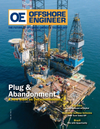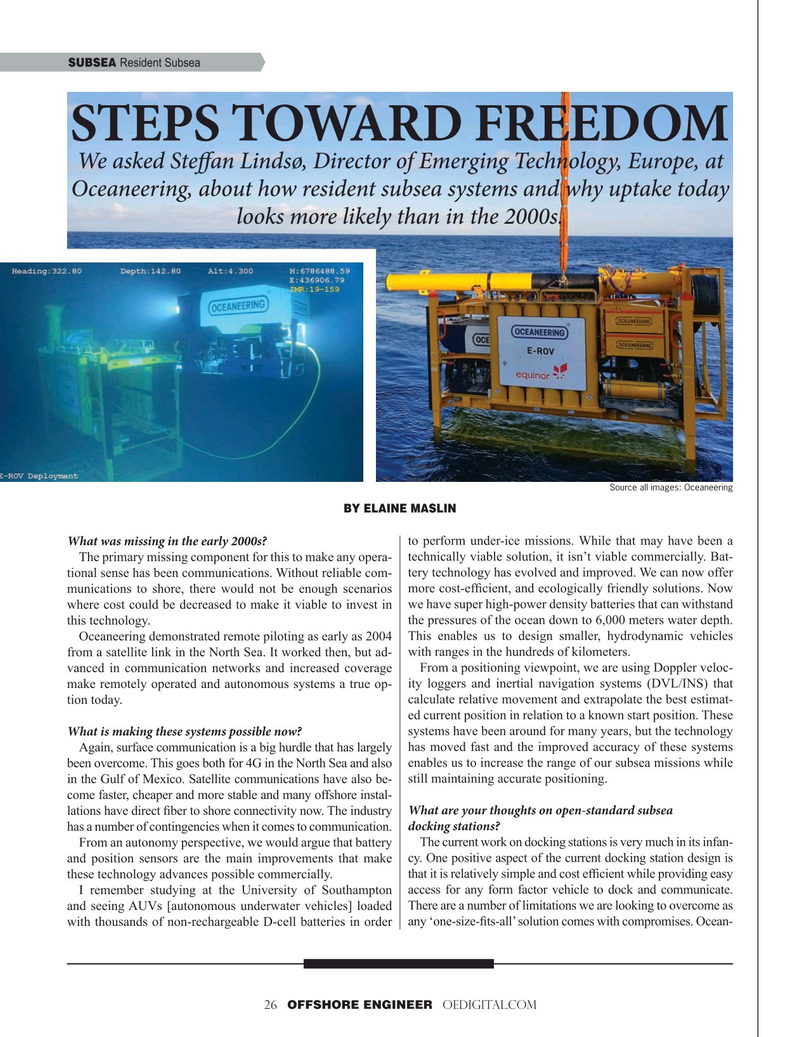
Page 26: of Offshore Engineer Magazine (Sep/Oct 2019)
Big Data and Digitalization
Read this page in Pdf, Flash or Html5 edition of Sep/Oct 2019 Offshore Engineer Magazine
SUBSEA Resident Subsea
STEPS TOWARD FREEDOM
We asked Stef an Lindsø, Director of Emerging Technology, Europe, at
Oceaneering, about how resident subsea systems and why uptake today looks more likely than in the 2000s.
Source all images: Oceaneering
BY ELAINE MASLIN
What was missing in the early 2000s? to perform under-ice missions. While that may have been a
The primary missing component for this to make any opera- technically viable solution, it isn’t viable commercially. Bat- tional sense has been communications. Without reliable com- tery technology has evolved and improved. We can now offer munications to shore, there would not be enough scenarios more cost-ef? cient, and ecologically friendly solutions. Now where cost could be decreased to make it viable to invest in we have super high-power density batteries that can withstand this technology. the pressures of the ocean down to 6,000 meters water depth.
Oceaneering demonstrated remote piloting as early as 2004 This enables us to design smaller, hydrodynamic vehicles from a satellite link in the North Sea. It worked then, but ad- with ranges in the hundreds of kilometers.
vanced in communication networks and increased coverage From a positioning viewpoint, we are using Doppler veloc- make remotely operated and autonomous systems a true op- ity loggers and inertial navigation systems (DVL/INS) that tion today. calculate relative movement and extrapolate the best estimat- ed current position in relation to a known start position. These
What is making these systems possible now? systems have been around for many years, but the technology
Again, surface communication is a big hurdle that has largely has moved fast and the improved accuracy of these systems been overcome. This goes both for 4G in the North Sea and also enables us to increase the range of our subsea missions while in the Gulf of Mexico. Satellite communications have also be- still maintaining accurate positioning.
come faster, cheaper and more stable and many offshore instal- lations have direct ? ber to shore connectivity now. The industry What are your thoughts on open-standard subsea has a number of contingencies when it comes to communication. docking stations?
From an autonomy perspective, we would argue that battery The current work on docking stations is very much in its infan- and position sensors are the main improvements that make cy. One positive aspect of the current docking station design is these technology advances possible commercially. that it is relatively simple and cost ef? cient while providing easy
I remember studying at the University of Southampton access for any form factor vehicle to dock and communicate. and seeing AUVs [autonomous underwater vehicles] loaded There are a number of limitations we are looking to overcome as with thousands of non-rechargeable D-cell batteries in order any ‘one-size-? ts-all’ solution comes with compromises. Ocean- 26 OFFSHORE ENGINEER OEDIGITAL.COM

 25
25

 27
27